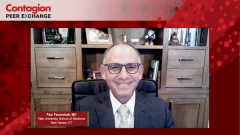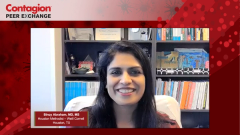
Risk Factors for Primary and Recurrent C. difficile Infection (CDI)
Drs Lodise and Feuerstadt discuss risk factors for C. difficile infection (CDI).
Episodes in this series

Paul Feuerstadt, MD: With that foundational knowledge in mind, Tom, can you walk us through some risk factors associated with initial infection for C [Clostridioides] difficile?
Thomas Lodise, PharmD, PhD: As you know, numerous risk factors for CDI have been described in the literature. When you look at these risk factors, I put them in 3 groupings: pharmacological risk factors, host-related risk factors, and clinical characteristics or interventions. As you mentioned, far and away, the biggest risk factors are the receipt of antibiotics. When you think about that in someone who’s colonized with C difficile and creating that dysbiosis, it often occurs in hospitalized patient. On any given day in 1 of our hospitals, over half of the patients are receiving antibiotics. Not surprisingly, we have over a half million cases of CDI in the United States.
When we think about antibiotic use, we look at that risk. Even 1 or 2 days of receipt of antibiotics predisposes individuals to an increased risk of CDI and the presence of colonization. We see a peaking in that risk after 3 to 14 days, but that risk continues even after discontinuation of antibiotics. It continues to be high for 5 days but can persist for months or even years depending on the antibiotic received. So we think about antibiotic stewardship. It’s always important to use the narrowest spectrum agent for the shortest duration possible.
Other medications are proton pump inhibitors, H2 blockers, and anything that raises the pH within the stomach. NSAIDs [nonsteroidal anti-inflammatory drugs], steroids, and SSRIs [selective serotonin reuptake inhibitors] all disrupt normal functioning of the bowel, lead to a situation of dysbiosis, and in the presence of C difficile, can cause disease. When we think about host-related risk factors, I always think about individuals with a defective humoral immunity or those who have baseline dysbiosis. Older adults, those with cancer, diverticulitis, and irritable bowel disease are also at an increased risk.
Finally, with clinical characteristics, much like antibiotic-resistant pathogens, it’s time at risk in environments where there are a lot of C difficile spores: nursing homes and long-term care facilities, particularly in patients in a hospital for an extended period; colonization with VRE [vancomycin-resistant enterococci] and other resistant organisms; people getting GI [gastrointestinal] procedures. All of these are clinical conditions that create an increased risk of CDI.
Paul, there’s 1 thing I’ll leave you with. It’s not any 1 risk factor; rather it’s the culmination of risk factors. This has been described well within the literature. What we see is an older patient getting multiple rounds of antibiotics, maybe in the ICU [intensive care unit] or coming from a nursing home. Those are our most vulnerable individuals.
Paul Feuerstadt, MD: Excellent. When we focus on patients who are hospitalized and those who are aging, why is C difficile infection such a significant concern for those patients?
Thomas Lodise, PharmD, PhD: When we think about the underlying pathophysiology, which you did a very nice job describing, they have defects in humoral immunity against that toxin B from C difficile. They have some baseline dysbiosis. They’re more vulnerable patient populations. The other thing I always think about is that we’re all at risk for CDI depending on our background risk factors. There are greater risks for complications associated with the disease. When we think about it, 1 in 10 people over 65 years old who get CDI die. Those individuals are at an increased risk of complications, whether that’s fulminant colitis, admission to an ICU, or sepsis. What we see in those greater than 65 is an increased baseline risk because of their collective conditions. When they do experience, they have increased morbidity and mortality.
Paul Feuerstadt, MD:I completely agree. In the hospital setting, you’re surrounded by other individuals who potentially have C difficile or can transfer it because they’re colonized. Those are all important points. Thank you. Now, what about differences in risk factors for initial infection vs risk factors for a current infection?
Thomas Lodise, PharmD, PhD: Paul, I look at them as largely overlapping. It’s the same patient type: older adults, those with baseline dysbiosis against defects in humoral immunity, patients getting recourses of antibiotics. If there’s never restoration of the microbiota and then they go get an antibiotic, that’s a perfect host for recurrent infection. With recurrent CDI, 25% on average get a recurrent infection. Once they get that recurrent infection, they go down that slippery slope. Everyone is at a 50% risk of a subsequent episode. Most of the things we think about in the infectious disease world are acute conditions, but CDI is 1 of those that probably fits into that chronic category because of the recurrent nature of the disease. A lot of the risk factors they have are unavoidable. How do you tell a person not to go back to a nursing home, where there’s a lot of circulating C difficile spores? How do you tell the person we need to get you out of the ICU when you’re sick? What we find is a host who’s vulnerable because certain conditions are unavoidable. If they get an infection, we have to treat them with antibiotics. It’s not surprising that we see the sequela of recurrent disease among certain individuals with C difficile.
Paul Feuerstadt, MD:I completely agree. We have to think about this, as you said, in terms of modifiable and unmodifiable risk factors. Unfortunately, a lot of these individuals have a lot of unmodifiable risk factors, but we need to be cognizant of some of the modifiable ones and realize that if we learn the risk factors for initial infection, we’re learning the risk factors for a current infection as well.
Transcript edited for clarity
Newsletter
Stay ahead of emerging infectious disease threats with expert insights and breaking research. Subscribe now to get updates delivered straight to your inbox.




























































































































































































































































































































